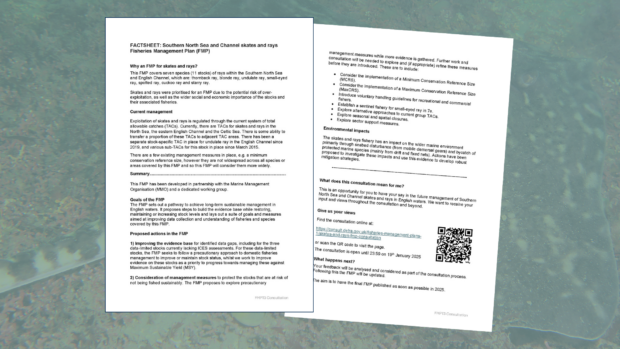https://defrafmp.blog.gov.uk/factsheet-southern-north-sea-and-channel-skates-and-rays-fisheries-management-plan-fmp/
FACTSHEET: Southern North Sea and Channel skates and rays Fisheries Management Plan (FMP)
Why an FMP for skates and rays?
This FMP covers seven species (11 stocks) of rays within the Southern North Sea and English Channel, which are: thornback ray, blonde ray, undulate ray, small-eyed ray, spotted ray, cuckoo ray and starry ray.
Skates and rays were prioritised for an FMP due to the potential risk of over-exploitation, as well as the wider social and economic importance of the stocks and their associated fisheries.
Current management
Exploitation of skates and rays is regulated through the current system of total allowable catches (TACs). Currently, there are TACs for skates and rays in the North Sea, the eastern English Channel and the Celtic Sea. There is some ability to transfer a proportion of these TACs to adjacent TAC areas. There has been a separate stock-specific TAC in place for undulate ray in the English Channel since 2019, and various sub-TACs for this stock in place since March 2015.
There are a few existing management measures in place, e.g. a minimum conservation reference size, however they are not widespread across all species or areas covered by this FMP and so this FMP will consider them more widely.
Summary
This FMP has been developed in partnership with the Marine Management Organisation (MMO) and a dedicated working group.
Goals of the FMP
The FMP sets out a pathway to achieve long-term sustainable management in English waters. It proposes steps to build the evidence base while restoring, maintaining or increasing stock levels and lays out a suite of goals and measures aimed at improving data collection and understanding of fisheries and species covered by this FMP.
Proposed actions in the FMP
1) Improving the evidence base for identified data gaps, including for the three data-limited stocks currently lacking ICES assessments. For these data-limited stocks, the FMP seeks to follow a precautionary approach to domestic fisheries management to improve or maintain stock status, whilst we work to improve evidence on these stocks as a priority to progress towards managing these against Maximum Sustainable Yield (MSY).
2) Consideration of management measures to protect the stocks that are at risk of not being fished sustainably. The FMP proposes to explore precautionary management measures while more evidence is gathered. Further work and consultation will be needed to explore and (if appropriate) refine these measures before they are introduced. These are to include:
- Consider the implementation of a Minimum Conservation Reference Size (MCRS).
- Consider the implementation of a Maximum Conservation Reference Size (MaxCRS).
- Introduce voluntary handling guidelines for recreational and commercial fishers.
- Establish a sentinel fishery for small-eyed ray in 7e.
- Explore alternative approaches to current group TACs.
- Explore seasonal and spatial closures.
- Explore sector support measures.
Environmental impacts
The skates and rays fishery has an impact on the wider marine environment primarily through seabed disturbance (from mobile demersal gears) and bycatch of protected marine species (mainly from drift and fixed nets). Actions have been proposed to investigate these impacts and use this evidence to develop robust mitigation strategies.
What does this consultation mean for me?
This is an opportunity for you to have your say in the future management of Southern North Sea and Channel skates and rays in English waters. We want to receive your input and views throughout the consultation and beyond.
Give us your views
Find the consultation online at: https://consult.defra.gov.uk/fisheries-management-plans-1/skates-and-rays-fmp-consultation
The consultation is open until 23:59 on 19 January 2025.
What happens next?
Your feedback will be analysed and considered as part of the consultation process. Following this the FMP will be updated.
The aim is to have the final FMP published as soon as possible in 2025.
For a printable version of this factsheet please contact FMPs@defra.gov.uk
